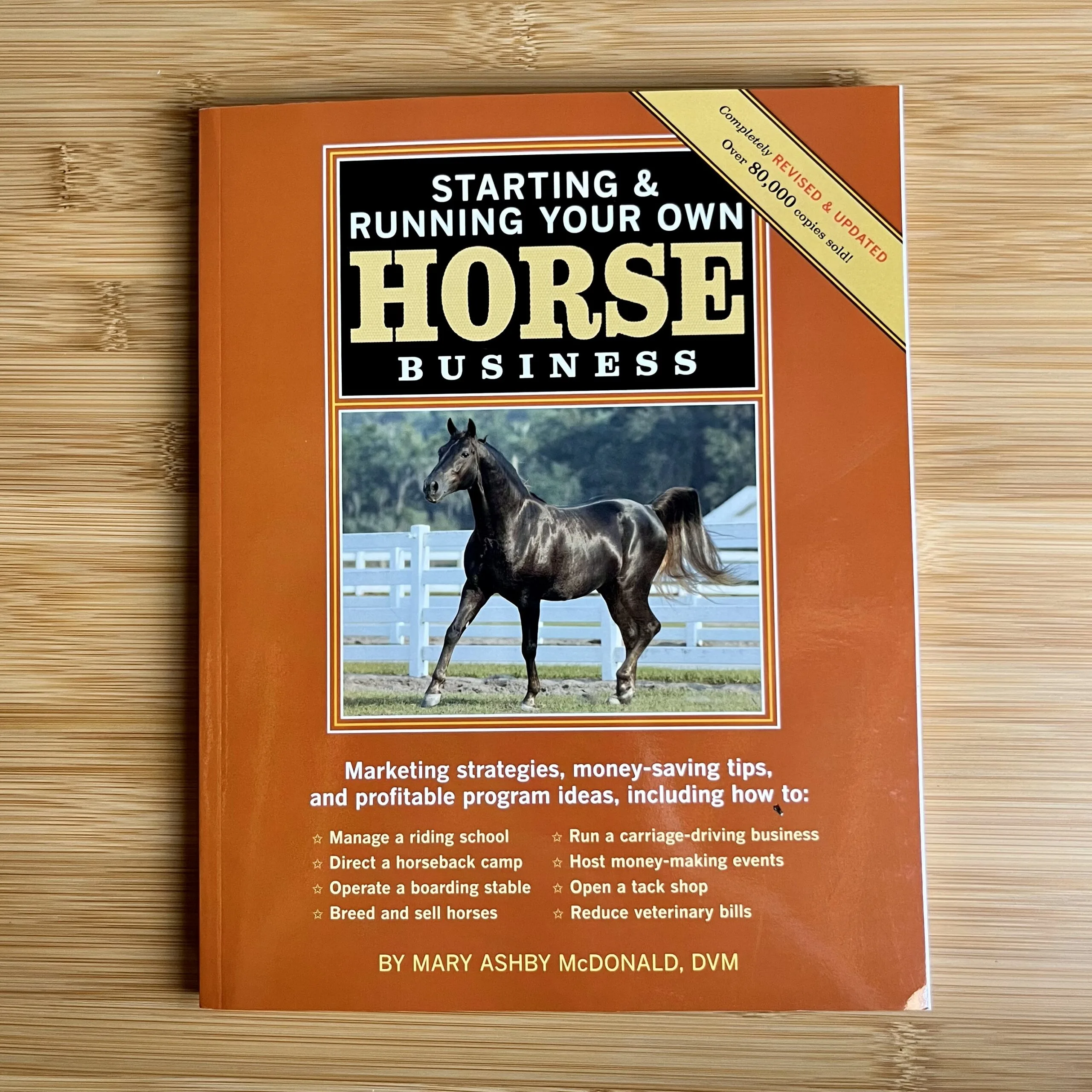The best way to deep clean a horse trough is a combination of water, bleach, sunshine, and elbow grease (aka scrubbing). Follow this guide to get your horse trough clean- really clean– in less time.
This article is split into 3 parts: How to Clean a Water Trough | Natural Ways to Keep Water Troughs Clean | and Creative Solutions for Livestock Water
How to Clean a Horse Trough:

How to clean a horse trough
Total Time: 15 minutes
Drain or Dump
To clean a horse trough, start by emptying it completely. Some troughs have a drain on the bottom, but if yours doesn’t, you will need to tip it over and dump the water (or bail or siphon out the water that’s in it until the water level is low enough that it can be tipped over and dumped).
Even if your trough has a drain, you’ll probably need to dump the trough to get every last bit of water. Standard Rubbermaid livestock troughs that include a drain still need to be tipped to be sure that all the water- including the sludge at the bottom- is removed before cleaning.
Scrub or Powerwash
Once you have dumped the trough, mix 1 cup of bleach to 1 gallon of water, and use it to scrub the inside of the trough. If your trough is only lightly soiled you can use a toilet bowl brush and go over it with a few quick swipes. If you have a really gross livestock tank you’ll need to get in a little deeper. You’ll need a better brush for troughs where algae has collected on the sides. The toilet brush doesn’t work to remove sediment from the sides because the leverage of the handle doesn’t allow you to apply enough pressure. Instead, grab a plastic bristled, plastic-backed scrub brush and aggressively scrub at the trough.
Avoid any scrub brush with a handle. Brushes that are designed to fit in your palm make it easier to scrub with pressure.
DON’T USE ABRASIVES TO CLEAN A PLASTIC TROUGH!
Unless you have a galvanized steel stock tank, don’t use an abrasive scrubber like steel wool or a wire grill cleaning brush. Although a steel wire brush will quickly remove algae, sediment, etc from plastic and molded troughs, these cleaners will leave tiny scratches on the surface which will collect bacteria, house algae and sediment, and will make your trough even harder to clean in the future.
Can you use a power washer to clean a horse trough? Maybe. Just like other abrasives, power washing can potentially scar the surface of plastic horse troughs. Because the water pressure can be adjusted, though, with the right setting a power washer can be a great tool to help speed up trough cleaning without damaging the surface.
Thanks to new technology, backpack-sized electric-powered powerwashers are a big help on a farm, making it safe and easy to use powerful jets of water to clean troughs, trailers, horse blankets, and fences.
Rinse and (if possible) Leave to Dry Fully
A scrub with bleach water should remove all unwanted algae, insect larvae, and bacteria, but for good measure, I like to let sunlight do a second round of cleaning. After dumping and scrubbing your tank, let your trough air out in a sunny space for an hour or two.
Sunlight works in two ways: neutralizing any bleach residue by breaking it down, and by killing any remaining micro-organisms.
Extend Time Between Cleanings through Good Trough-Management
Once your horse trough is clean, check out our tips on keeping your horse trough clean naturally to reduce the frequency and difficulty of cleaning in the future.
Supply:
- bleach
- bail bucket
- scrub brush
Tools:
- (optional) power washer
The best tools for cleaning a horse trough are as follows:
The following section may contain affiliate links. As an Amazon Associate, we earn from qualifying purchases.
For Daily Maintenance: A Fresh, Dedicated Toilet Bowl Brush
For Dump-and-Scrub Deep Cleans: A Big Hand-Held Scrub Brush (no handles!)
For ultra-fast deep cleaning: Portable Lightweight Power Washer
A plastic-backed, plastic bristled brush is best for scrubbing. Even better if it has a handle loop. Bucket brushes with handles that extend out from the body tend to stress the wrist, but styles that strap onto your palm make scrubbing with pressure much easier.
Cover your Trough to Prevent Algae Growth
Styrofoam is not essential for cleaning your trough, but it’s a huge help in keeping it clean. A Styrofoam float that covers ½ to ¾ of your trough – leaving just enough room for a horse or two to drink, can keep water cooler in the summer (and warmer in the winder) helping prevent algae blooms.
Foam exercise mats tend to work better than styrofoam- which will break down into particles as it age. We like interlocking foam panels for layering to create trough covers. Cut to fit the shape of your trough and glue layers together for durability- use a black mat for one side and a white mat for the other. Flip the 2-color mat each season to draw in heat from sunlight or reflect it.
If you have very curious horses, You can cover your trough with heavy-duty plywood cut to fit over the rim of your trough and secure it with C clamps.
How to keep mosquitoes out of a horse trough
In some parts of the country, managing mosquitoes can feel like a full-time job for horse owners. Here’s what you need to know to keep your horse trough are stock to take a mosquito-free:
- Mosquitoes like stagnant water. Prevent mosquitoes from laying eggs and nesting by: changing the water regularly. Weekly flush and refill will prevent any mosquito larvae from hatching.
- Add a mosquito dunk – according to the EPA, mosquito dunks are safe for use in horse troughs and fish habitats. They prevent mosquito larvae from hatching by interrupting the development of larvae.
- Keep the water moving. A water agitator or even a floating solar-powered fountain can prevent mosquitoes from ever laying eggs in troughs.
- Be mindful of your natural partners in mosquito prevention. Bats, dragonflies, and even fish can help with mosquito control. Read up on how to promote these natural predators.
- Add fish to your trough. Not recommended for small troughs, but for large troughs, a few fish can have a positive benefit on water quality by eating larva from insects and even some small debris dropped by horses.
- Treat the whole farm. If you have trouble with mosquitoes in your trough, part of it may be because mosquitoes are already in the area. Look for standing water near your property. If possible, treat these areas first. Then, keeping your horse trough and stock tanks mosquito-free will be easier.
Watering Horses with Chlorinated water
Chlorinated water is safe for horses as long as the water is at human-safe levels.
You might be surprised to learn that adding tiny amounts of bleach to a horse trough can be an effective way to control algae. While it’s not recommended as the first line of defense, bleach is approved by the CDC as a way to treat water for humans in times of crisis. When it comes to water quality, horses and humans aren’t that different. If humans can safely drink water, a horse should be able to as well.
Far more dangerous to horses is a big shift from one unfiltered water source to another. As long as your horse is used to treated tap water, you should be able to travel and water your horse from any other tap water in the USA (thanks to standards that keep tap water pretty similar from one area to another). On the other hand, if you use well water to water your horse, switching to another water source may upset some horse’s stomach. This is due to the abrupt change in mineral content.
If you’ll be traveling with your horse and cant be sure you’ll have similar water quality, you may want to bring water from home for your horse to drink.
How to Kill Algae and Clean a Horse Trough Using UV light
One of the most novel ways to prevent algae – and prevent it completely- is to install a UV filter. For about $100, you can install a Natural-algae killing UV filter that sits on the bottom of your trough or stock tank.
Although it should be installed with a cage or a bit of fencing to protect it, this type of filter runs a stream of water over a strong UV light inside. Just like strong sunlight, the UV light will naturally kill every bit of algae, parasites, and larvae in the water with no chemicals needed.
Although I don’t know anyone using this UV-light water management system on a horse farm currently, when I allowed my horse to graze in my front yard, my horse would often drink out of my garden pond.
The garden pond was a favorite of both horses and chickens – the untreated well water combined with the UV filter and constant movement made it an irresistible drinking source. When my horses were turned loose from their paddocks to roam the gated property each night, often their very first stop was to drink out of the garden pond with its free-flowing waterfall and UV filtered water.
Sunshine or shade for algae control?
Like most plants, algae requires sunlight to perform basic photosynthesis and survive. What’s interesting about algae, however, is that too much sunlight also kills it. While algae depends on sunlight to grow, direct light – or too high UV rays – instantly kills algae. This is why UV filters are such powerful algae controllers. Does this mean that you should put your trough in sunlight or shade to best control algae? This answer varies depending on who you ask, but generally placing a trough in a slightly shaded area will result in less algae, however, natural shade – like a tree – can result in leaves, seeds, or sap dropping into the trough which can contaminate water or cause bacterial growth.
Dealing with Green water in a Trough
If the water in your trough turns green, it’s a signal of a big problem in trough management. While it’s normal for algae to grow and even to blooms heavily on occasion, you should aim to clean out your trough frequently enough that in the water never turns green. If your trough is too big to dump regularly, install this basic drain with a simple on/off switch and began draining off a portion of the water every few days. If you top off the trough with fresh water each time you partially drain, the regular influx of freshwater will minimize the algae blooms that turn water green. Read more natural ways to keep a horse trough clean.
Recycling & Reusing Horse Trough Water
When it’s time to drain, dump, and refill a horse trough, most horse owners simply unplug the drain and let the water flow. There’s a few problems with this: the biggest issue is that this often creates a muddy mess around the trough. Whether it’s summer show season or winter frozen mud, mud around a trough can be a problem for grooming and hoof health.
To remedy this- and be a little more environmentally friendly with your wastewater- convert your drain to a spigot to which a hose can be attached. Once you’ve done this quick conversion, you can direct the wastewater from your horse trough, with all its rich bacterial life, onto a garden or into a storm drain where it can safely be treated and returned to the water supply.
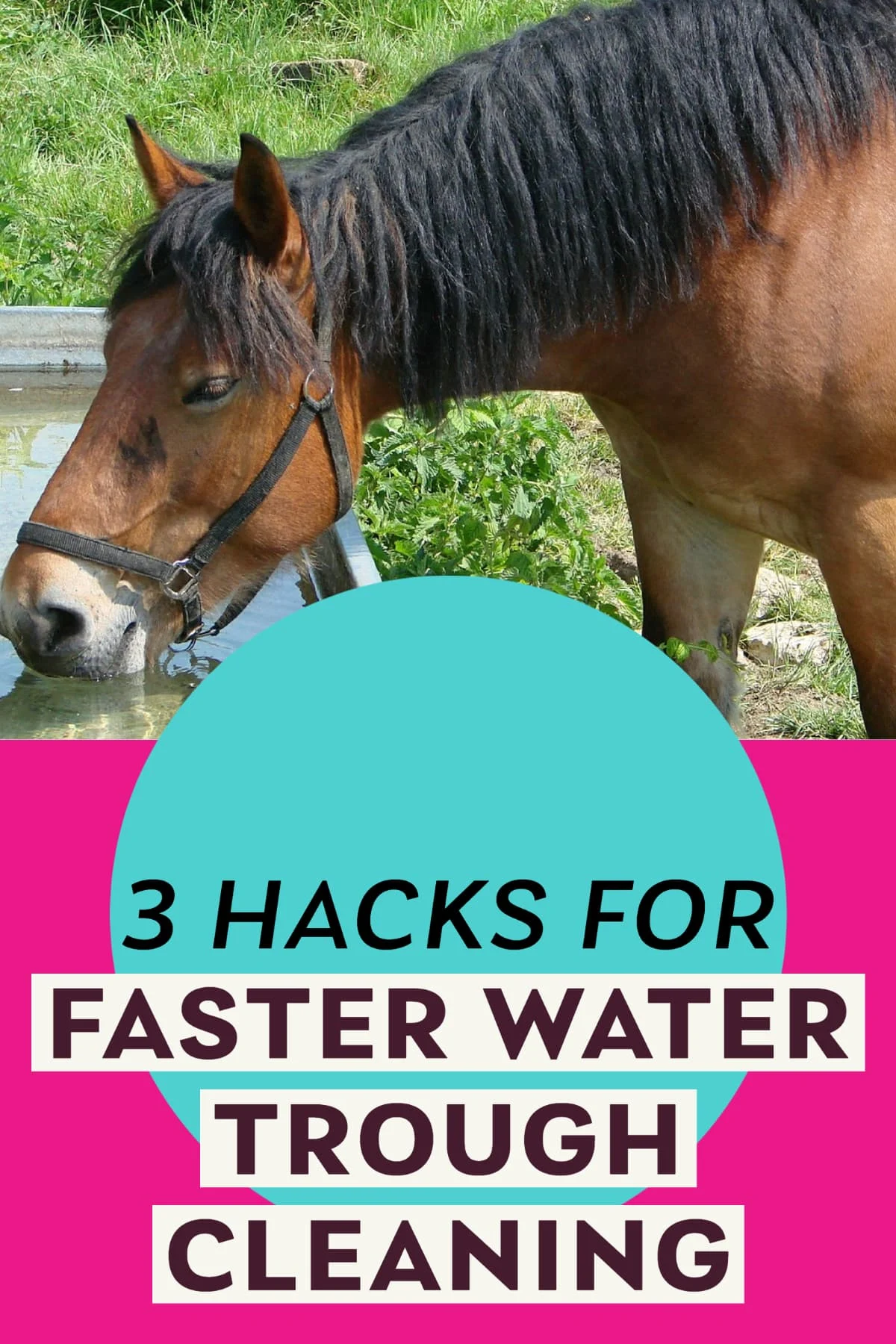
Natural Tips for Keeping Horse Troughs Clean
Keeping your horse’s water clean naturally can be a challenge – many horses love to slosh around in an open trough with both face and hooves, and even when they aren’t dirtying their water through play it’s common to find your horse’s water trough filled with dropped food, insects, and on occasionally horrifying occasions in the heat of summer, small drowned birds or squirrels. Constantly dumping filling troughs can be both expensive and wasteful of precious water.
This article will discuss a few non-chemical methods to keep water sitting in your horse’s trough fresh and clean. When you’re done, check out our ultimate guide to deep cleaning a horse trough and explore some alternative horse water trough types.
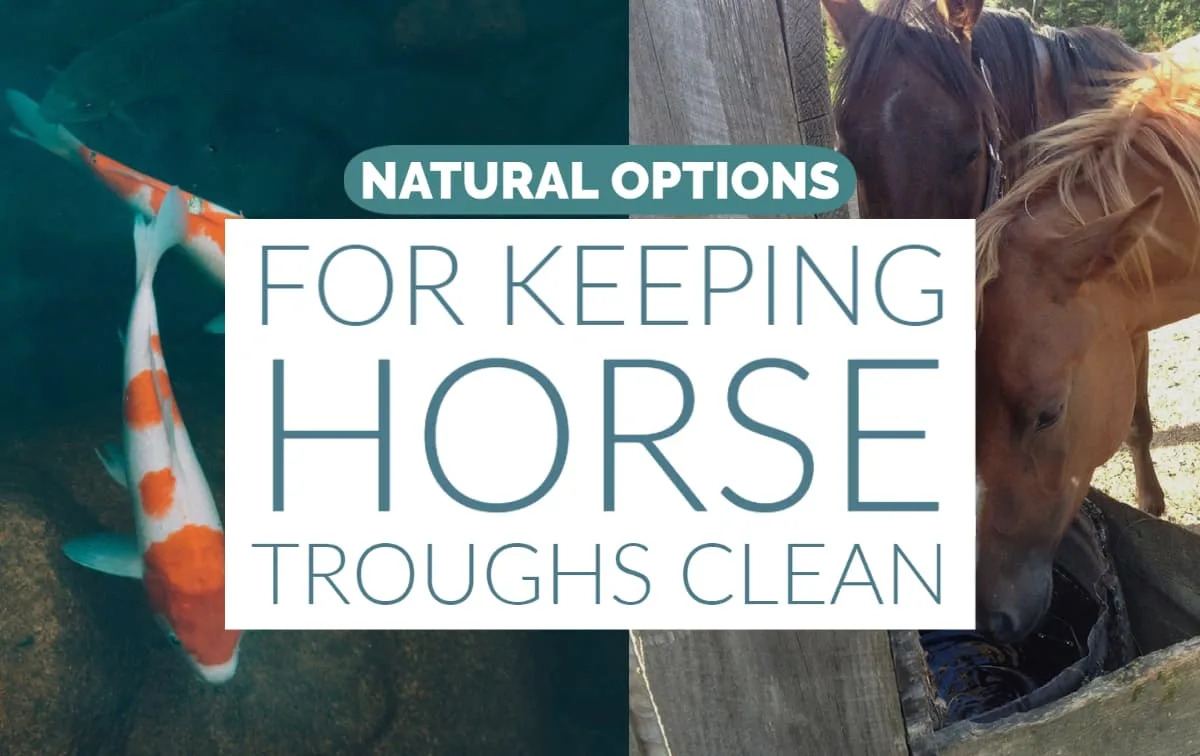
1. Use a smaller trough:
One of the reasons that horse trough water grows sour is that the water sits stagnant for long periods. If you use a smaller trough and fill it often, the turnover rate will be much higher and the water will be fresher. If you’re worried about your horses running out of water, you may be able to install automatic waterers in your pastor or make your own with a muck bucket and a water refill valve.
1. Use a LARGER trough
Remarkably, given that smaller troughs help keep algae and bacteria growth down, very large troughs can also combat algae and bacteria. With the right care, a large trough can be a balanced ecosystem. Food debris dropped by horses feed goldfish, and their waste feeds plants. The plants then filter the water in the pond. This kind of trough requires a 300+ gallon tank and attention to balancing elements.
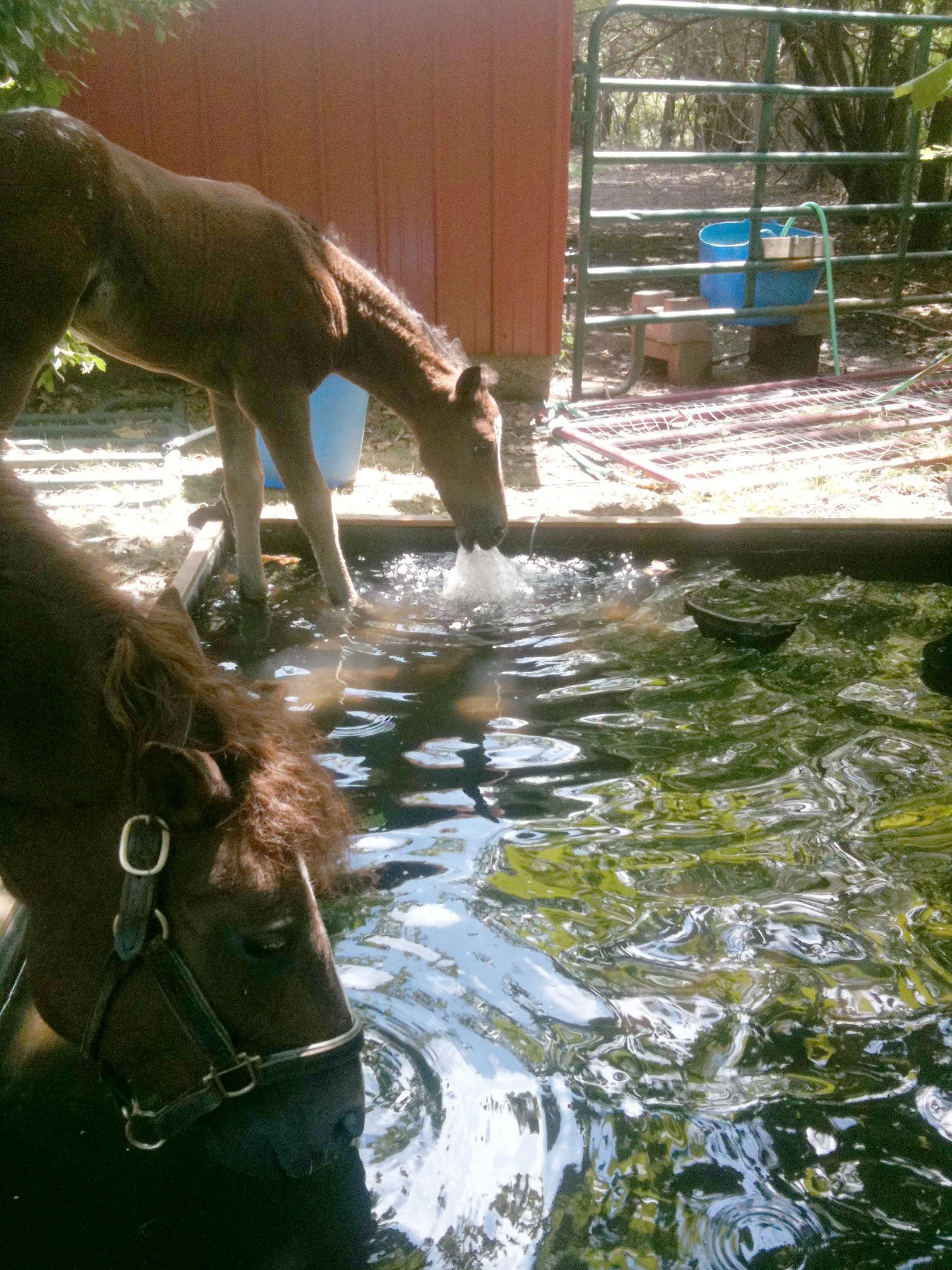
3. Goldfish
one strange and weirdly popular natural method for keeping horse troughs clean is to place goldfish in the horses’ water trough. In a large tank, fish can reduce the cleaning needed to maintain a clean trough and freshwater. A few small goldfish swimming in your trough can help control the mosquito, bug, and algae populations- even better, the goldfish do not need to be fed as they will feed on algae, bugs, and food particulate dropped by horses.
The best place to get a fish that will survive and thrive in your horse’s water trough is a garden pond supply store where you can purchase a small feeder fish brand for outdoor ponds. If this is not available, you can visit a local pet store and buy a few of their smallest goldfish. Shop at least six goldfish, as goldfish from pet stores often are not healthy enough to survive. However, healthy goldfish that survive the first week have a very good shot at a long and healthy life in the bottom of your horse’s trough, living a life of luxury in a giant fishbowl and growing much larger than their aquarium-bound comrades.
Goldfish often survive winter in horse troughs, insulated by water and protected by their own biological protection. Our mid-Missouri farm tiny feeder goldfish can grow up to 3-4 inches over the course of several summers.
4. Cover your tank
covering the top of your trough can limit the amount of sunlight that reaches the water. Algae is one of the main causes of both foul water and scummy buildup on the inside of the trough, and algae depend on sunlight to grow. By installing a cover on top of a portion of your water trough, you can cut light reaching the water by 50% or more and limit the growth of algae by the same amount.
To install a cover, cut a piece of plywood to fit the contours of your trough rim, leaving at least a 24″ x 24″ area open for horses to drink, and use C clamps to clamp the cover securely on top of the trough. To boost wintertime insulation, use two layers of plywood and add a layer of Styrofoam between them.
5. UV filter
borrowing from the water gardening subculture, one way to keep stagnant water fresh, healthy, and bacteria free is by using a UV filter to kill bacteria and algae. A UV filter requires a small investment and an investment in a pump and housing for the units but can reduce your water trough cleaning time exponentially. The trough placed next to a fence can drain into a UV filter set insecure housing on the other side of the fence and pumped back into the horse’s trough using a small garden pond water pump.
Creative Watering for Horse Pastures and Barns
It wasn’t long after bringing our horses home to our first farm that we discovered the magic of auto-waterers. Plumbed automatic livestock waterers can cost upwards of $1000 to install but we quickly discovered a cheap alternative. This inexpensive piece of plumbing equipment pictured below can turn almost ANY water container into an automatically-refilling bucket or trough. An auto-refill valve halpes make sure that our horses always have clean, fresh water available. (For winter watering tips, be sure to check out our article on winter water management for horses and an article about how to build a naturally self-heating trough)
The photo below shows an automatic livestock waterer that was built into our original barn. With a cast iron tub and wood box built to protect the float from curious animals (not necessary if you use the part above, which self-shields), this built-in auto waterer is a unique and handy piece of farm equipment. This automatic waterer was designed for cattle but works efficiently and safely for horses provided there are not enough to crowd it.
In later years, before we moved to our Hawk-Hill location, the stall where this waterer was located was screened in and converted to a chicken coop. The elongated water basin (which one old farmer told me, rather convincingly, was actually a cast iron urinal from a early 20th-century men’s stadium restroom!) made an excellent community nesting box and the wood panel behind the box, which was originally hinged to allow caretakers to check water levels on the waterer, served as a perfect reach-through egg gathering door.
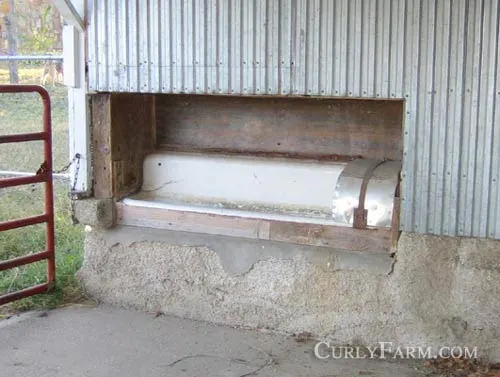
Unusual Horse Troughs
In addition to the cast iron urinal-turned-water-trough above, we’ve used several other unorthodox watering methods on our farm. In this photo (which shows, in the background, the auto-waterer described above in action) you can see a mare and foal drinking from a low trough. This trough was actually built using Hawk Hill’s Instructions for a DIY pond made from old vinyl billboard material. Kept full using the same float valve described above, using the garden pond as an alternative water source kept our pond turning over at a natural rate.
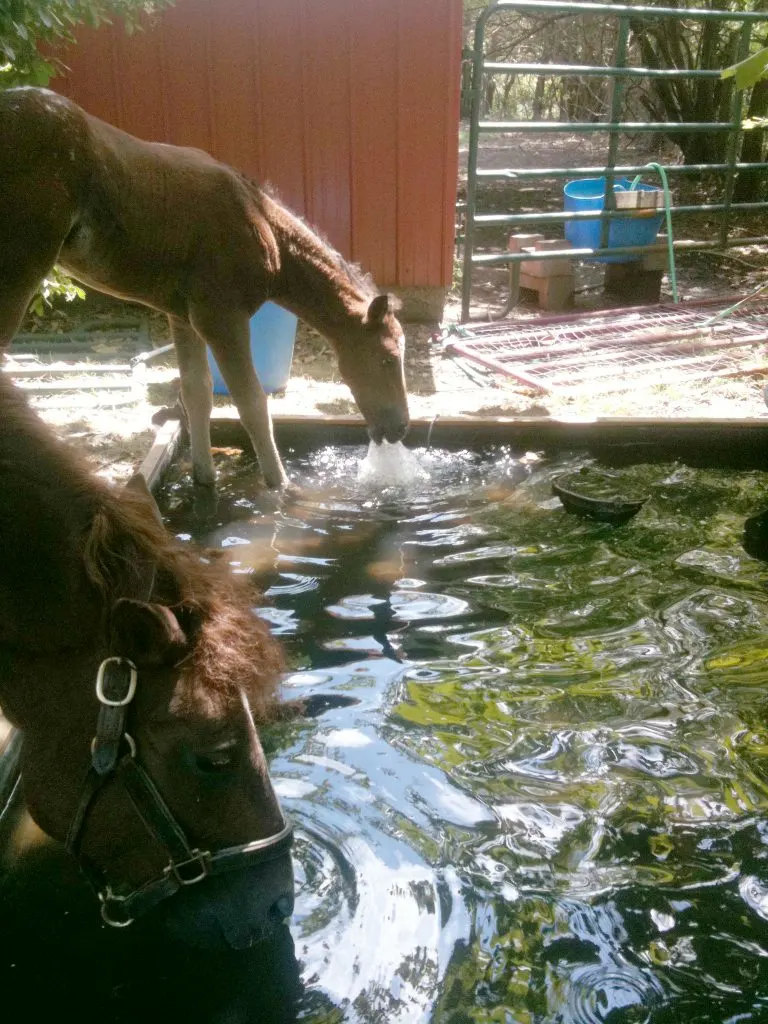
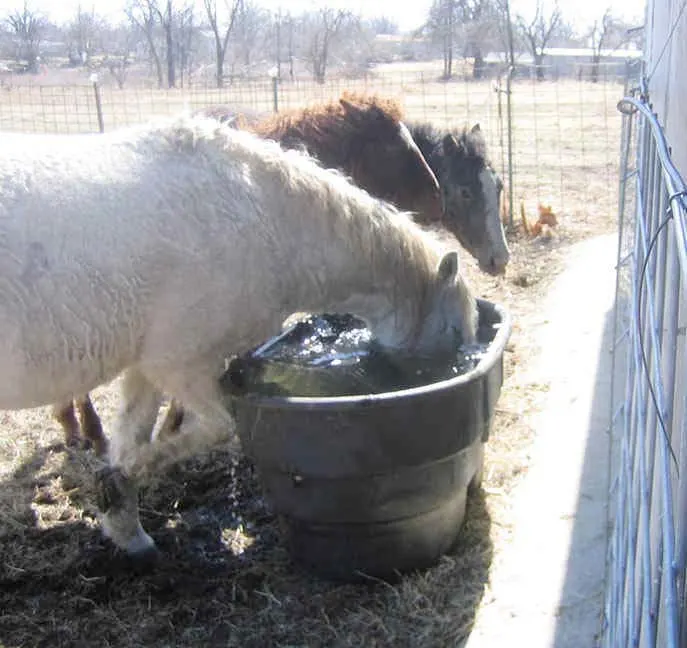
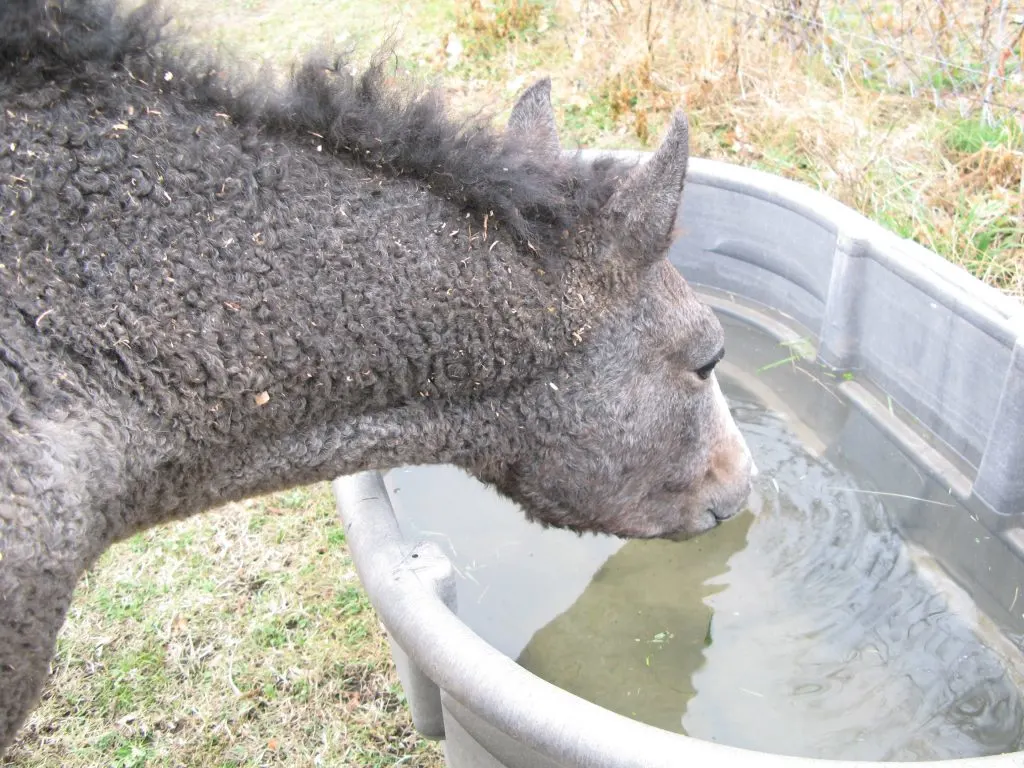
For more information from experienced stable owners, check out these two books! From suggestions around feeding troughs to generally keeping things clean and healthy for your horse, these books are a wealth of equine knowledge.


